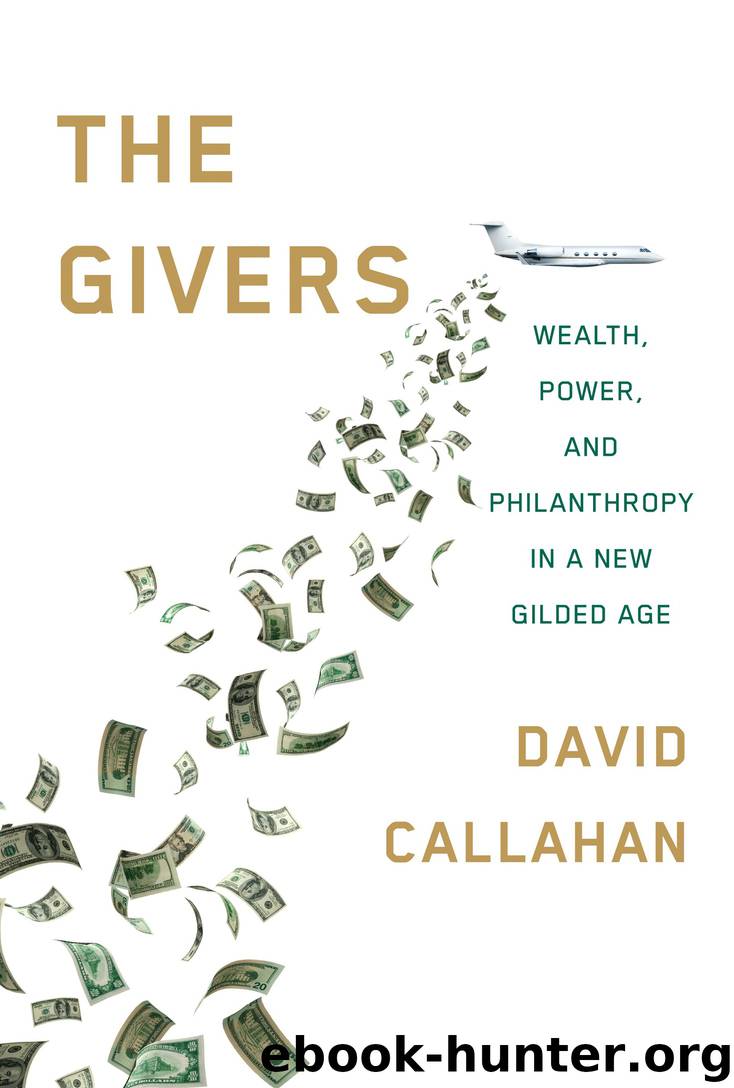The Givers by David Callahan

Author:David Callahan
Language: eng
Format: epub, mobi
Publisher: Knopf Doubleday Publishing Group
Published: 2017-04-10T16:00:00+00:00
THE WAR ON COAL
Climate change is one area where deep-pocketed philanthropists have lately had a big influence by bankrolling advocacy, with Michael Bloomberg near the forefront of this push.
After the Bush administration rejected the Kyoto Protocol, in 2005 then-mayor Bloomberg joined a coalition of mayors who pledged to curb greenhouse gases at the local level. The following year, in a commencement speech at Johns Hopkins, he slammed those blocking action on climate change: “Despite near-unanimity in the science community, there’s now a movement, driven by ideology and short-term economics, to ignore the evidence and discredit the reality of climatic change.” During his second term as mayor, Bloomberg unveiled an ambitious plan to reduce the city’s greenhouse gas emissions, and later became chairman of a group of mayors from major cities around the world fighting climate change.
In 2010, early in his third term, Bloomberg was looking to step up his philanthropy even as he spent his days governing Gotham. His fortune had soared during his years in office, as Bloomberg terminals proliferated ever more widely, and he had plenty of cash to spare for sideline pursuits. Bloomberg strongly considered a big push into education reform and asked his longtime advisor, Kevin Sheekey, to bring him ideas in that area.
At a meeting at Gracie Mansion, Sheekey floated an education idea that didn’t go over well. “It was a terrible meeting in every way, and Mike was angry,” Sheekey later told Politico. “I said: ‘Look, if you don’t like this idea, that’s fine. We’ll bring you another.’ He said: ‘No, I want another now.’ ”
Before the meeting, Sheekey had eaten lunch with Carl Pope, the head of the Sierra Club, who was starting a push to raise $50 million to expand the club’s Beyond Coal campaign, which worked at the state and local level to shut down coal plants across the country. At the time, the campaign was only operating in fifteen states; Pope wanted to expand the effort to forty-five states. He saw this as a way to make progress on climate change even as efforts to pass a cap-and-trade bill were fizzling in Congress. But Pope also told Sheekey that closing coal plants could have a big impact on public health by lowering the number of deaths from air pollution. In other words, the Beyond Coal campaign aimed to advance not one, but two of Bloomberg’s passions.
Bloomberg was sold on the idea of getting behind the campaign. “We’ll just give Carl a check for the $50 million,” he said. “Tell him to stop fundraising and get to work.”
It didn’t turn out to be that simple. Naturally, Bloomberg wanted metrics and data so that he could gauge the progress of the Sierra Club’s work. He wanted detailed indicators to guide the effort, analyzing coal plants across the country. He “put us through the ringer,” a Sierra Club executive said later. But thanks to Bloomberg’s prodding, the group would go on to build a comprehensive database that tracked the retirement of coal plants and the gains from such closures in terms of public health and reduced carbon emissions.
Download
This site does not store any files on its server. We only index and link to content provided by other sites. Please contact the content providers to delete copyright contents if any and email us, we'll remove relevant links or contents immediately.
| Anarchism | Communism & Socialism |
| Conservatism & Liberalism | Democracy |
| Fascism | Libertarianism |
| Nationalism | Radicalism |
| Utopian |
The Secret History by Donna Tartt(18849)
The Social Justice Warrior Handbook by Lisa De Pasquale(12142)
Thirteen Reasons Why by Jay Asher(8796)
This Is How You Lose Her by Junot Diaz(6794)
Weapons of Math Destruction by Cathy O'Neil(6146)
Zero to One by Peter Thiel(5686)
Beartown by Fredrik Backman(5599)
The Myth of the Strong Leader by Archie Brown(5425)
The Fire Next Time by James Baldwin(5249)
How Democracies Die by Steven Levitsky & Daniel Ziblatt(5128)
Promise Me, Dad by Joe Biden(5087)
Stone's Rules by Roger Stone(5026)
A Higher Loyalty: Truth, Lies, and Leadership by James Comey(4845)
100 Deadly Skills by Clint Emerson(4840)
Rise and Kill First by Ronen Bergman(4704)
Secrecy World by Jake Bernstein(4646)
The David Icke Guide to the Global Conspiracy (and how to end it) by David Icke(4625)
The Farm by Tom Rob Smith(4438)
The Doomsday Machine by Daniel Ellsberg(4416)
